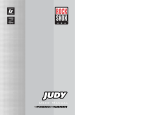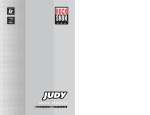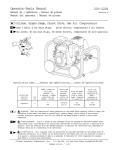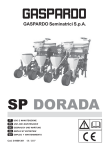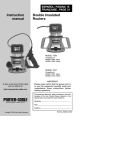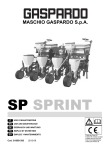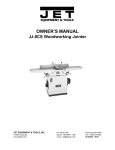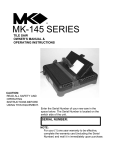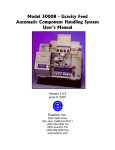Download Porter-Cable 698 User's Manual
Transcript
E S PA OL: P`GINA 19 FRAN˙AISE : PAGE 37 Instruction manual Router/Shaper and Shaper Table MODEL 697 Router/Shaper Complete MODEL 698 Shaper Table Only To learn more about Porter-Cable visit our website at: http://www.porter-cable.com IMPORTANT Please make certain that the person who is to use this equipment carefully reads and understands these instructions before starting operations. The Model and Serial No. plate is located on the main housing of the tool. Record these numbers in the spaces below and retain for future reference. Model No. __________________________________ Type_______________________________________ Serial No. ___________________________________ Part No. 884901-991 SAFETY INSTRUCTIONS GROUNDING INSTRUCTIONS This tool should be grounded while in use to protect the operator from electric shock. The tool is equipped with an approved three-conductor cord and threeprong grounding type plug to fit the proper grounding type receptacle. The green (or green and yellow) conductor in the cord is the grounding wire. Never connect the green (or green and yellow) wire to a live terminal. If your unit is for use on less than 150 Volts, the power cord is equipped with a plug that has two flat, parallel current-carrying prongs and one longer, round or U -shaped, ground prong which requires a mating 3conductor grounded type receptacle, as shown in Fig. 1. An adapter, shown in Fig. 2, is available for connecting 3-prong grounding type plugs that are used on units less than 150 Volts to 2-prong receptacles. THIS ADAPTER IS NOT ALLOWED IN CANADA. The green colored rigid ear, lug, etc., must be connected to a permanent ground such as a properly grounded outlet box, as shown in Fig. 2. If your unit is for use on 150 to 250 Volts, the power cord is equipped with a plug that has two flat current carrying prongs in tandem, and one round or U -shaped, longer ground prong, as shown in Fig. 3. This plug is used only with the proper mating 3conductor grounding type receptacle, as shown in Fig. 3. No adapter is available for this type plug. IN ALL CASES, MAKE SURE THE RECEPTACLE IN QUESTION IS PROPERLY GROUNDED. GROUNDED OUTLET BOX CURRENT CARRYING PRONGS GROUNDING PRONG IS LONGEST OF THE 3 PRONGS Fig. 1 GROUNDED OUTLET BOX GROUNDING MEANS ADAPTER Fig. 2 GROUNDED OUTLET BOX CURRENT CARRYING PRONGS GROUNDING PRONG IS LONGEST OF THE 3 PRONGS Fig. 3 NEVER REMOVE GROUNDING PRONG FROM POWER PLUG. EXTENSION CORDS Use only three-wire extension cords which have three-prong grounding-type plugs and three-pole receptacle which accept the tool s plug. Replace damaged or worn cord immediately. DO NOT ATTEMPT TO REPAIR POWER CORD. 2 IMPORTANT SAFETY INSTRUCTIONS WARNING: When using electric tools, basic safety precautions should always be followed to reduce the risk of fire, electric shock and personal injury, including the following: READ AND FOLLOW ALL INSTRUCTIONS. There are certain applications for which this tool was designed. Porter-Cable strongly recommends that this tool NOT be modified and/or used for any application other than for which it was designed. If you have any questions relative to its application DO NOT use the tool until you have written PorterCable and we have advised you. Technical Service Manager Porter-Cable Corporation 4825 Highway 45 North P. O. Box 2468 Jackson, TN 38302-2468 1. KEEP WORK AREA CLEAN. Cluttered areas and benches invite injuries. 2. AVOID DANGEROUS ENVIRONMENT. Don t expose power tools to rain. Don t use power tools in damp or wet locations. Keep area well lit. Avoid chemical or corrosive environment. Do not use tool in presence of flammable liquids or gases. 3. GUARD AGAINST ELECTRIC SHOCK. Prevent body contact with grounded surfaces. For example: pipes, radiators, ranges, refrigerator enclosures. 4. KEEP CHILDREN AWAY. Do not let visitors contact tool or extension cord. All visitors should be kept away from work area. 5. STORE IDLE TOOLS. When not in use, tools should be stored in dry, and high or locked-up place out of reach of children. 6. DON T FORCE TOOL. It will do the job better and safer at the rate for which it was intended. 7. USE RIGHT TOOL. Don t force small tool or attachment to do the job of a heavy duty tool. Don t use tool for purpose not intended for example do not use a circular saw for cutting tree limbs or logs. 8. DRESS PROPERLY. Do not wear loose clothing or jewelry. Loose clothing, draw strings and jewelry can be caught in moving parts. Rubber gloves and non-skid footwear are recommended when working outdoors. Wear protective hair covering to contain long hair. 9. USE SAFETY GLASSES. Wear safety glasses or goggles while operating power tools. Also face or dust mask if operation creates dust. All persons in the area where power tools are being operated should also wear safety glasses and face or dust mask. 10. DON T ABUSE CORD. Never carry tool by cord or yank it to disconnect from receptacle. Keep cord from heat, oil, and sharp edges. Have damaged or worn power cord and strain reliever replaced immediately. DO NOT ATTEMPT TO REPAIR POWER CORD. 11. MAKE WORKSHOP KIDPROOF. Use padlocks, master switches, or by removing starter keys. 12. SECURE WORK. Use clamps or a vise to hold work when practical. 3 13. DON T OVERREACH. Keep proper footing and balance at all times. 14. MAINTAIN TOOLS WITH CARE. Keep tools sharp and clean for better and safer performance. Follow instructions for lubricating and changing accessories. Inspect tool cords periodically and if damaged, have repaired by authorized service facility. Inspect extension cords periodically and replace if damaged. Have all worn, broken or lost parts replaced immediately. Keep handles dry, clean and free from oil and grease. 15. DISCONNECT TOOLS when not in use, before servicing, and when changing accessories such as blades, bits, cutters, etc. 16. REMOVE ADJUSTING KEYS AND WRENCHES. Form habit of checking to see that keys and adjusting wrenches are removed from the tool before turning it on. 17. AVOID UNINTENTIONAL STARTING. Do not carry a plugged-in tool with finger on switch. Be sure switch is off when plugging in. Keep hands, body and clothing clear of blades, bits, cutters, etc. when plugging in the tool. 18. OUTDOOR USE EXTENSION CORDS. When tool is used outdoors, use only extension cords marked Suitable for use with outdoor appliances store indoors when not in use. 19. STAY ALERT. Watch what you are doing. Use common sense. Do not operate tool when you are tired or while under the influence of medication, alcohol or drugs. 20. USE RECOMMENDED ACCESSORIES. Consult the owner s manual for recommended accessories. The use of improper accessories may cause risk of injury to persons. 21. NEVER STAND ON TOOL. Serious injury could occur if the tool is tipped or if the cutting tool is unintentionally contacted. 22. CHECK DAMAGED PARTS. Before further use of the tool, a guard or other part that is damaged should be carefully checked to determine that it will operate properly and perform its intended function. Check for alignment of moving parts, binding of moving parts, breakage of parts, mounting, and any other conditions that may affect its operation. A guard or other part that is damaged should be properly repaired or replaced. 23. DIRECTION OF FEED. Feed work into a blade or cutter against the direction of rotation of the blade or cutter only. 24. NEVER LEAVE TOOL RUNNING UNATTENDED. TURN POWER OFF. Don t leave tool until it comes to a complete stop. 25. WEAR EAR PROTECTION to safeguard against possible hearing loss. SAVE THESE INSTRUCTIONS ADDITIONAL SAFETY RULES FOR ROUTER/SHAPER 1. DO NOT USE awkward hand positions. 2. KEEP FINGERS AWAY from revolving cutter necessary. use fixtures when 3. USE CUTTER GUARDS for all applications. 4. KEEP CUTTER GUARDS IN PLACE and in working order. 5. KEEP CUTTERS SHARP. 4 6. NEVER RUN STOCK between fence and cutter. 7. WHEN SHAPING with piloted bit, the pilot must have sufficient bearing surface (1… 8" minimum) as shown in Fig. 1. Fig. 2 illustrates the INCORRECT method for this operation as the pilot DOES NOT have sufficient bearing surface. CORRECT INCORRECT Fig. 1 Fig. 2 8. WHEN SHAPING, the work must be fairly heavy in proportion to the cut being made as shown in Fig. 3. UNDER NO CIRCUMSTANCE should short work of light body be shaped as shown in Fig. 4. CORRECT INCORRECT Fig. 3 Fig. 4 9. THE FENCE should be adjusted endwise so the opening is never more than is required to clear the cutter. 10. CLAMP OR BOLT shaper table securely to workbench to prevent walking . 11. DO NOT USE router bits larger in diameter than those recommended for your router (see SELECTING THE BIT). 12. WHEN SHAPING NARROW MATERIAL, use a push stick and make sure the material is properly supported. 13. WHEN END SHAPING, make sure the material is properly supported by using a miter gauge or back-up block. 14. SOME WOOD CONTAINS PRESERVATIVES WHICH CAN BE TOXIC. Take extra care to prevent inhalation and skin contact when working with these materials. Request, and follow, any safety information available from your material supplier. REPLACEMENT PARTS When servicing use only identical replacement parts. M O TOR Many Porter-Cable tools will operate on either D.C., or single phase 25 to 60 cycle A.C. current and voltage within plus or minus 5 percent of that shown on the specification plate on the tool. Several models, however, are designed for A.C. current only. Refer to the specification plate on your tool for proper voltage and current rating. 5 CAUTION: Do not operate your tool on a current on which the voltage is not within correct limits. Do not operate tools rated A.C. only on D.C. current. To do so may seriously damage the tool. EXTENSION CORD SELECTION If an extension cord is used, make sure the conductor size is large enough to prevent excessive voltage drop which will cause loss of power and possible motor damage. A table of recommended extension cord sizes will be found in this section. This table is based on limiting line voltage drop to 5 volts (10 volts for 230 volts) at 150% of rated amperes. If an extension cord is to be used outdoors it must be marked with the suffix W-A following the cord type designation. For example SJTW-A to indicate it is acceptable for outdoor use. RECOMMENDED EXTENSION CORD SIZES FOR USE WITH PORTABLE ELECTRIC TOOLS O P E R ATING INSTRUCTIONS FOREWORD Models 697 and 698 are designed to perform various shaping operations using standard router bits. Model 698 can be used with any Porter-Cable (or Rockwell) Professional Router. If using Model 7538 or 7539 Plunge Router: a Model 75300 Height Adjustment Knob must be installed and the Shaper Table must be mounted on a Model 6961 Stand (or a cut-out table) that provides clearance for the 75300 Adjustment Knob (the knob will extend below the bottom of the Shaper Table legs). ASSEMBLING TA B L E 1. Locate the two table legs (see Fig. 5) and stand them up parallel to each other and approximately 12" apart. The leg with the switch mounted in it should be to your right, with the switch facing you. Both legs should slant toward the outside. 2. Open hardware package. 3. Place the table on top of the legs, with the miter gauge slot up and the large hole to the rear. Secure the table to the legs with four 1… 4-20 ¥ 13… 8" long, flat head screws, split lockwashers, and nuts. 6 G H A B C D E J D F E B A F G H J C Left Leg Right Leg Table Left Fence Bracket Right Fence Bracket/ Guard Assembly Fence (2) Rear Cutter Guard/ Dust Port Hardware Package Miter Gage Fig. 5 A A Fig. 6 Fig. 7 4. Mount the router base (see Fig. 6 for non-plunge routers, or Fig. 7 for plunge routers), to the underside of the table using screws from the hardware package (routers with less than 2 horsepower use three #10-24 x 3… 4" long screws, routers with more than 2 horsepower except Model 7529 use four 5 … 16"-18 x 11… 4" screws, and Model 7529 uses three 10-24 x 11… 16" screws). Orient the router base directly below the large hole in the table, with the clamp screw (A) Fig. 6, (or the plunge locking lever (A) Fig. 7, on plunge models), toward the rear of the table. NOTE: The router sub-base must be removed before mounting to table. 5. Place router motor into base and tighten clamp screw to secure (nonplunge models only). 6. Position the rear cutter guard (A) Fig. 8, to the right fence bracket and top cutter guard assembly. Secure with two #10-32 x 3… 8" screws. NOTE: The rear cutter guard also provides a 21… 2" diameter dust collection port. 7. Position the right hand (in-feed) fence bracket and guard assembly (A) Fig. 9, to the slot on the right side of the table. Insert a 5… 16"-18 x 11… 4" carriage bolt (from the hardware package), up through the table and the fence bracket. Secure by threading on one of the black knobs. 7 A B A Fig. 9 Fig. 8 8. Assemble the left hand (out-feed) fence bracket (B) Fig. 9, to the table in a similiar fashion. 9. Position the wooden fences to the fence brackets (see Fig. 10), and secure using one, 3… 8"-16 x 11… 5" bolt and matching nut, through each fence and fence bracket. Fig. 10 FASTENING ROUTER/SHAPER TO WORK BENCH The Router/Shaper should be securely attached to a firm supporting structure (such as a work bench) to prevent movement of the machine during use. Two holes are provided in the bottom flange of each leg for mounting bolts, or the bottom leg flanges may be clamped to the support with C-clamps. SELECTING THE BIT The Router/Shaper will accommodate bits with shanks that are installed directly into the power unit collet. A table insert with the smallest diameter hole that will clear the selected bit should always be used. CAUTION: Do not use router bits larger in diameter than those recommended for your router (see following chart): 8 PORTER-CABLE / ROCKWELL PROFESSIONAL ROUTERS Router Model Max. Bit Diameter All Models rated less than 2 Horsepower 21… 8" All Models rated over 2 Horsepower 31… 2" INSTALLING AND REMOVING BIT 1. CAUTION: DISCONNECT MACHINE FROM POWER SOURCE. 2. Clean and insert shank of bit into collect until shank bottoms. Then back it . out approximately 1… 16" 3. Place chuck wrench (A) Fig. 11, through opening in rear of base and engage flats of chuck. 4. Move chuck wrench (A) Fig. 11, to the left side of base opening: place collet wrench (B) Fig. 11, through opening in router base, move collet wrench to right side of base opening and engage flats of collet nut (or flats of collet depending on the specific router motor being used). 5. Grasp both wrenches and squeeze together (see Fig. 12). 6. Repeat Steps 3 thru 5 until collet is tightened securely. 7. To remove the bit, reverse the foregoing procedure. NOTE: Avoid possible damage to collet. Never tighten collet without bit. A B Fig. 11 Fig. 12 ADJUSTING BIT EXPOSURE CAUTION: DISCONNECT MACHINE FROM POWER SOURCE BEFORE MAKING ADJUSTMENTS. NON-PLUNGE ROUTER 1. Loosen clamp screw (A) Fig. 13. 2. Turn motor until desired bit exposure above table is reached: clockwise rotation of motor (viewed from chuck end of motor) reduces bit exposure, counterclockwise rotation increases bit exposure. 3. Firmly tighten clamp screw (A) Fig. 13, to secure motor in base. PLUNGE ROUTER MODEL 693 1. Grasp motor unit firmly and hold while moving the plunge locking lever (on the router), to the released position. 2. While holding the plunge release lever in the released position: lift motor unit until desired bit exposure is reached. 3. Release the plunge locking lever and push lever to the locked position. 9 A Fig. 13 PLUNGE ROUTER MODEL 7538 OR 7539 1. Move the plunge locking lever (on the router), to the released position. 2. Rotate Model 75300 Height Adjustment Knob to raise or lower cutter to the desired position. 3. Release plunge locking lever and push lever to the locked position. ADJUSTING THE FENCE Each fence may be adjusted individually for front-to-back position and for side-to-side position. Front-to-back position of the right (in-feed) fence will control the amount of material that is removed in each pass. Front-to-back position of the left (out-of-feed) fence is set to support the workpiece as it leaves the cutter. Side-to-side position should be adjusted so that each fence is just clear of the bit path (this will provide maximum support for the workpiece). Adjust as follows: CAUTION: DISCONNECT MACHINE FROM POWER SOURCE BEFORE MAKING ADJUSTMENTS. 1. Loosen right fence knob (A) Fig. 14, and right fence screw (B) Fig. 14. 2. Slide the wooden fence to the right to clear bit as you move fence assembly into the desired position front-to-back . Tighten knob (A) Fig. 14, to secure fence assembly in position. 3. Position right wooden fence so that it just clears the bit path, and secure by tightening screw (B) Fig. 14. 4. Loosen left fence knob (C) Fig. 14, and right fence screw (D) Fig. 14. 5. Slide the wooden fence to the left to clear bit as you move fence assembly into the desired position front-to-back . Tighten knob (C) Fig. 14, to secure fence assembly in position. 6. Position left wooden fence so that it just clears the bit path, and secure by tightening screw (D) Fig. 14. 10 C A B D Fig. 14 CONNECTING TO POWER SOURCE CAUTION: Before connecting to power source ALWAYS MAKE SURE THE SWITCH IS IN THE OFF POSITION and that the power circuit is the same as that shown on the specification plate of the Router/Shaper. 1. Plug the motor cord into the short cord extending from the table switch box. 2. Turn the router motor switch ON motor operation will now be controlled by the switch in the front of the table. 3. With the table switch OFF , connect the long power cord extending from the table switch box to the power source. STARTING AND STOPPING THE MOTO R CAUTION: Before starting the motor, make sure work piece and all foreign objects are clear of bit and that guards are in place over bit. TO START MOTOR Move switch lever (A) Fig. 15 up to the ON position. A Fig. 15 TO STOP MOTOR Move switch lever (A) Fig. 15 to the OFF position. SWITCH LOCK The switch may be locked in the OFF position by removing the switch key while the switch is in the OFF position. To lock switch, place switch in OFF position and pull switch key out of switch (see Fig. 16). Check to make sure switch is in OFF position. CAUTION: D I S C O N N E C T M A C H I N E F R O M POWER SOURCE BEFORE REMOVING SWITCH KEY TO PREVENT ACCIDENTAL STARTING WHILE PULLING SWITCH KEY. A Fig. 16 11 USING THE ROUTER/SHAPER WARNING: Figures 17 and 20 through 27 show machine with cutter guards removed for clarity. NEVER O P E R A T E Router/Shaper without guards in place. IMPORTANT: Before using your machine, consider the kind and total amount of rnaterial to be removed. Depending on the material, it may be necessary to make more than one cut to avoid overloading the motor. Before beginning the cut on the actual workpiece, it is advisable to make a sample cut on a piece of scrap lumber. This will show exactly how the cut will look as well as enable you to check dimensions. The cutter rotates in a counterclockwise direction (viewing from above). Always feed work against the cutter rotation as shown in Fig. 17. WARNING: Serious injury could result if workpiece is not always fed into the cutter against the direction of rotation. The speed and depth of cut will depend largely on the type of material being worked upon. Keep the cutting pressure constant but do not crowd the machine so the motor speed slows excessively. It may be necessary on exceptionally hard woods or problem materials to make more than one pass at various settings to get the desired depth of cut. When making cuts on all four edges of the workpiece, it is advisable to have the first cut on the end of the piece across the grain. Thus, if chipping of wood occurs at the end of a cut, it will be removed when making the next cut parallel with the grain. OUT-FEED FENCE IN-FEED FENCE CUTTING CIRCLE DEPTH OF CUT FEED Fig. 17 SHAPING WITH PILOTED BITS For shaping irregular edges a starting pin (A) Fig. 19, is furnished with your Router/Shaper for use with piloted router bits. Before installing the starting pin, remove: the retaining clips (A) Fig. 18, the front guard (B) Fig. 18, and the left hand (out-feed) fence assembly. WARNING: Do not remove the right hand (in-feed) fence, top cutter guard, and rear cutter guard assembly. This assembly must remain in place and be adjusted so that the top guard completely covers the installed cutter. Insert starting pin into either hole (C) or (D) Fig. 19. For majority of shaping operations the starting pin should be installed in hole (C) Fig. 19, as work must be fed against the direction of rotation of the cutter. 12 B A A A D C Fig. 19 Fig. 18 When using piloted bits only part of the edge of the workpiece can be cut since it is necessary to have the other part riding against the pilot. WARNING: Never leave less than 1… 8" of the workpiece to ride against the pilot. Leaving less than 1… 8" could cause the edge to splinter possibly resulting in serious injury. Adjust the right hand (in-feed) fence and guard assembly so that the top guard completely covers the cutting area of the installed cutter. Turn machine ON and allow it to come to full speed. Place workpiece in first position (see Fig. 20). Using the starting pin as a support, swing workpiece into cutter (second position Fig. 20). When cut is started, press workpiece against piloted bit and swing workpiece away from starting pin. After the cut is started the piloted bit acts as a guide and not the starting pin. Feed workpiece against the direction of rotation of the cutter until complete edge is shaped. Slide workpiece away from cutter and turn machine OFF . STARTING PIN 1ST POSITION CUTTING CIRCLE 2ND POSITION PILOT WORK PILOT STARTING PIN CUTTING CIRCLE WORK 2ND POSITION 3RD POSITION Fig. 20 13 SHAPING WITH FENCE When shaping straight edges, the fence can be used as a guide. The entire fence assembly or either the infeed or outfeed section can be adjusted independently as outlined under Adjusting the Fence . For normal work where a portion of the original edge of the work is not altered by the cutter, both the front and rear fences are in a straight line, as shown in Fig. 21. NOTE: Always check fences for correct alignment. The workpiece must slide along both fences smoothly. Always make a trial cut on scrap material to check your set-up. OUT-FEED FENCE IN-FEED FENCE CUTTING CIRCLE DEPTH OF CUT FEED Fig. 21 For shaping operations that remove the entire end of the work, the shaped edge will not be supported by the outfeed fence when both fences are in-line, as shown in Fig. 22. In this case, the work should be advanced to the position shown in Fig. 22, and stopped. CAUTION: DISCONNECT MACHINE FROM POWER SOURCE BEFORE MAKING ADJUSTMENTS. OUT-FEED FENCE IN-FEED FENCE NO SUPPORT FEED WORK Fig. 22 The out-feed fence should then be advanced to contact the work, as shown in Fig. 23. OUT-FEED FENCE IN-FEED FENCE FEED Fig. 23 14 END SHAPING Sufficient support of the work piece must be maintained during all shaping operations. This exists when the workpiece is long enough to rest firmly against both the infeed and outfeed fences when you are halfway through the cut. When end shaping a workpiece that is not long enough to be sufficiently supported halfway through the cut, a miter gauge (available as an accessory) or back-up block must be used (see Fig. 24 and 25). WARNING: Any attempt to end shape a narrow workpiece without sufficient support could result in serious injury. When using the miter gauge, the infeed fence assembly must be parallel to the miter slot. The outfeed fence must be adjusted so that it will not contact the workpiece after it has passed the cutter. Place workpiece firmly against the miter gauge and infeed fence and feed into cutter by pushing the miter gauge. WARNING: Failure to hold workpiece firmly against miter gauge during cut could result in slippage of the workpiece causing serious injury and damage to the workpiece. MITER GAUGE BACK-UP BLOCK WARNING: KEEP HANDS AWAY FROM CUTTER WARNING: KEEP HANDS AWAY FROM CUTTER Fig. 24 Fig. 25 CROSS-GRAIN SHAPING When shaping across the grain, some splitting at the end of the cut may result. This can be minimized by feeding the workpiece slowly across the cutter at the end of the cut. When shaping all four sides of a workpiece, do the cross-grain cuts first. Doing with-the-grain cuts last will usually remove the splintered end. Fig. 26 15 SHAPING NARROW MATERIAL When shaping narrow material (less than 3" wide) a support as shown in Fig. 27 must be clamped to your Router/Shaper and the workpiece fed under this support with a push stick. The push stick should be slightly narrower and thinner than the workpiece. WARNING: Shaping narrow material without proper support and push stick could result in serious injury. 18 " PUSH STICK SLIGHTLY NARROW AND THINNER THAN WORKPIECE WORK SUPPORT WORKPIECE WARNING: KEEP HANDS AWAY FROM CUTTER Fig. 27 MAINTENANCE K E E P TO O L C L E A N Periodically blow out all air passages with dry compressed air. Remove buildup of grime resulting from working with green or sappy wood. All plastic parts should be cleaned with a soft damp cloth. NEVER use solvents to clean plastic parts. They could possibly dissolve or otherwise damage the material. CAUTION: Wear safety glasses while using compressed air. FAILURE TO STA R T Should your tool fail to start, check to make sure the prongs on the cord plug are making good contact in the outlet. Also, check for blown fuses or open circuit breakers in the line. LUBRICATION This tool has been lubricated with a sufficient amount of high grade lubricant for the life of the unit under normal operating conditions. No further lubrication is necessary. 16 BRUSH INSPECTION At approximately 100 hours of use, take or send your tool to your nearest Authorized Porter-Cable Service Station to be thoroughly cleaned and inspected; worn parts replaced, when necessary; relubricated with fresh lubricant, if required; reassembled with new brushes; and performance tested. Any loss of power before the above maintenance check may indicate the need for immediate servicing of your tool. DO NOT CONTINUE TO OPERATE TOOL UNDER THIS CONDITION. If proper operating voltage is present, return your tool to the Service Station for immediate service. S E RVICE AND REPAIRS All quality tools will eventually require servicing or replacement of parts due to wear from normal use. These operations, including brush inspection and replacement, should ONLY be performed by either an AUTHORIZED PORTER-CABLE SERVICE STATION or a PORTER-CABLE SERVICE CENTER. All repairs made by these agencies are fully guaranteed against defective material and workmanship. We cannot guarantee repairs made or attempted by anyone other than these agencies. Should you have any questions about your tool, feel free to write us at any time. In any communications, please give all information shown on the nameplate of your tool (model number, type, serial number, etc.). ACCESSORIES The testing of this tool has been accomplished with the following accessories. For safest operation, it is recommended that only these accessories be used with this product. WARNING: Since accessories other than those listed have not been tested with this product, use of such accessories could be hazardous. 6970 75300 6961 42596 Miter Gage Plunge Router Height Adjustment Knob (use with Models 7538 and 7539) Shaper Table Stand Collet Wrench 17 PORTER-CABLE LIMITED ONE YEAR WA R R A N T Y Porter-Cable warrants its Professional Power Tools for a period of one year from the date of original purchase. We will repair or replace, at our option, any part or parts of the product and accessories covered under this warranty which, after examination, proves to be defective in workmanship or material during the warranty period. For repair or replacement, return the complete tool or accessory, transportation prepaid, to your nearest Porter-Cable Service Center or Authorized Service Station. Proof of purchase may be required. This warranty does not apply to repair or replacement required due to misuse, abuse, normal wear and tear or repairs attempted or made by other than our Service Centers or Authorized Service Stations. ANY IMPLIED WARRANTY, INCLUDING THE IMPLIED WARRANTIES OF MERCHANTABILITY AND FITNESS FOR A PARTICULAR PURPOSE, WILL LAST ONLY FOR ONE (1) YEAR FROM THE DATE OF PURCHASE. To obtain information on warranty performance please write to: PORTER-CABLE CORPORATION, 4825 Highway 45 North, P.O. Box 2468, Jackson, Tennessee 38302-2468; Attention: Product Service. THE FOREGOING OBLIGATION IS PORTER-CABLE S SOLE LIABILITY UNDER THIS OR ANY IMPLIED WARRANTY AND UNDER NO CIRCUMSTANCES SHALL PORTER-CABLE BE LIABLE FOR ANY INCIDENTAL OR CONSEQUENTIAL DAMAGES. Some states do not allow limitations on how long an implied warranty lasts or the exclusion or limitation of incidental or consequential damages, so the above limitation or exclusion may not apply to you. This warranty gives you specific legal rights and you may also have other legal rights which vary from state to state. 18 PORTER-CABLE SERVICE CENTERS (CENTROS DE SERVICIO DE PORTER-CABLE) (CENTRE DE SERVICE PORTER-CABLE) Parts and Repair Service for Porter-Cable Power Tools are Available at These Locations (Obtenga Refaccion de Partes o Servicio para su Herramienta en los Siguientes Centros de Porter-Cable) (Locations oø vous trouverez les piŁces de rechange nØcessaires ainsi qu un service d entretien) ARIZONA Tempe 85282 (Phoenix) 2400 West Southern Avenue Suite 105 Phone: (602) 437-1200 Fax: (602) 437-2200 GEORGIA Forest Park 30297 (Atlanta) 5442 Frontage Road, Suite 112 Phone: (404) 608-0006 Fax: (404) 608-1123 MINNESOTA Minneapolis 55429 4315 68th Avenue North Phone: (612) 561-9080 Fax: (612) 561-0653 Cleveland 44125 8001 Sweet Valley Dr. Unit #19 Phone: (216) 447-9030 Fax: (216) 447-3097 CALIFORNIA Ontario 91761 (Los Angeles) 3949A East Guasti Road Phone: (909) 390-5555 Fax: (909) 390-5554 ILLINOIS Addison 60101 (Chicago) 311 Laura Drive Phone: (630) 628-6100 Fax: (630) 628-0023 MISSOURI North Kansas City 64116 1141 Swift Avenue P.O. Box 12393 Phone: (816) 221-2070 Fax: (816) 221-2897 PENNSYLVANIA Willow Grove 19090 520 North York Road Phone: (215) 658-1430 Fax: (215) 658-1433 San Leandro 94577 (Oakland) 3039 Teagarden Street Phone: (510) 357-9762 Fax: (510) 357-7939 COLORADO Denver 80216 5855 Stapleton Drive North Suite A-140 Phone: (303) 370-6909 Fax: (303) 370-6969 FLORIDA Hialeah 33014 (Miami) 16373-75 NW 57th Ave. Phone: (305) 624-2523 Fax: (305) 628-2654 Tampa 33609 4538 W. Kennedy Boulevard Phone: (813) 877-9585 Fax: (813) 289-7948 MARYLAND Elkridge 21075 (Baltimore) 7397-102 Washington Blvd. Phone: (410) 799-9394 Fax: (410) 799-9398 MASSACHUSETTS Franklin 02038 (Boston) Franklin Industrial Park 101E Constitution Blvd. Phone: (508) 520-8802 Fax: (508) 528-8089 MICHIGAN Troy 48083 (Detroit) 1355 Combermere Phone: (248) 597-5000 Fax: (248) 597-5004 St. Louis 63119 7574 Watson Road Phone: (314) 968-8950 Fax: (314) 968-2790 TENNESSEE Nashville 37214 2262 Lebanon Pike Phone: (615) 882-0320 Fax: (615) 882-0051 NEW YORK Flushing 11365-1595 (N.Y.C.) 175-25 Horace Harding Expwy. Phone: (718) 225-2040 Fax: (718) 423-9619 TEXAS Dallas 75220 10720 N. Stemmons Freeway Phone: (214) 353-2996 Fax: (214) 350-3943 NORTH CAROLINA Charlotte 28209 4303-B South Boulevard Phone: (704) 525-4410 Fax: (704) 525-0618 Houston 77055 West 10 Business Center 1008 Wirt Road, Suite 120 Phone: (713) 682-0334 Fax: (713) 682-4867 OHIO Columbus 43214 4560 Indianola Avenue Phone: (614) 263-0929 Fax: (614) 263-1238 WASHINGTON Renton 98055 (Seattle) 268 Southwest 43rd Street Phone: (425) 251-6680 Fax: (425) 251-9337 Authorized Service Stations are located in many large cities. Telephone 800-487-8665 or 901-541-6042 for assistance locating one. Parts and accessories for Porter-Cable products should be obtained by contacting any Porter-Cable Distributor, Authorized Service Center, or Porter-Cable Factory Service Center. If you do not have access to any of these, call 888-848-5175 and you will be directed to the nearest Porter-Cable Factory Service Center. Las Estaciones de Servicio Autorizadas estÆn ubicadas en muchas grandes ciudades. Llame al 800-487-8665 al 901-541-6042 para obtener asistencia a fin de localizar una. Las piezas y los accesorios para los productos PorterCable deben obtenerse poniØndose en contacto con cualquier distribuidor Porter-Cable, Centro de Servicio Autorizado o Centro de Servicio de FÆbrica Porter-Cable. Si no tiene acceso a ninguna de estas opciones, llame al 888-848-5175 y le dirigirÆn al Centro de Servicio de FÆbrica Porter-Cable mÆs cercano. Des centres de service agrØØs sont situØs dans beaucoup de grandes villes. Appelez au 800-487-8665 ou au 901-541-6042 pour obtenir de l aide pour en repØrer un. Pour obtenir des piŁces et accessoires pour les produits Porter-Cable, s adresser tout distributeur Porter-Cable, centre de service agrØØ ou centre de service d usine Porter-Cable. Si vous n avez accŁs aucun de ces centres, appeler le 888-848-5175 et on vous dirigera vers le centre de service d usine Porter-Cable le plus proche. D E LTA S E RVICE CENTERS ALBERTA Bay 6, 2520-23rd St. N.E. Calgary, Alberta T2E 8L2 Phone: (403) 735-6166 Fax: (403) 735-6144 MANITOBA 1699 Dublin Avenue Winnipeg, Manitoba R3H 0H2 Phone: (204) 633-9259 Fax: (204) 632-1976 BRITISH COLUMBIA 8520 Baxter Place Burnaby, B.C. V5A 4T8 Phone: (604) 420-0102 Fax: (604) 420-3522 ONTARIO 644 Imperial Road Guelph, Ontario N1H 6M7 Phone: (519) 836-2840 Fax: (519) 767-4131 QU BEC 1515 ave. St-Jean Baptiste, QuØbec, QuØbec G2E 5E2 Phone: (418) 877-7112 Fax: (418) 877-7123 1447, Begin St-Laurent, (MontrØal), QuØbec H4R 1V8 Phone: (514) 336-8772 Fax: (514) 336-3505 The following are trademarks of PORTER-CABLE Corporation (Las siguientes son marcas registradas de PORTER-CABLE S.A.) (Les marques suivantes sont des marques de fabriquant de la PORTER-CABLE Corporation): PORTER-CABLEfi , OMNIJIGfi , POCKET CUTTERfi , PORTAB A N Dfi , PORTA-PLANEfi , QUICKSANDfi , VERSA-PLANEfi , SANDTRAPfi , SAW BOSSfi , SPEED-BLOCfi , SPEEDMATICfi , SPEEDTRONICfi , STAIR-EASE fi , THE PROFESSIONAL EDGE fi , TIGER CUB fi , TIGER SAW fi , TORQ-BUSTER fi , DURATRONIC , FRAME SAW , JETSTREAM , MICRO-SET , MORTEN , PROFESSIONAL SELECT , QUIK-CHANGE , TRU-MATCH , WOODWORKER S CHOICE . Trademarks noted with fi are registered in the United States Patent and Trademark Office and may also be registered in other countries. Las Marcas Registradas con el signo de fi son registradas por la Oficina de Registros y Patentes de los Estados Unidos y tambiØn pueden estar registradas en otros pa ses. Marques dØposØes, indiquØes par la lettre fi, sont dØposØes au Bureau des brevets d invention et marques dØposØes aux Etats-Unis et pourraient Œtre dØposØes aux autres pays. Copyright ' 1998 PORTER-CABLE Corporation Printed in U.S.A.























